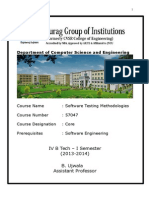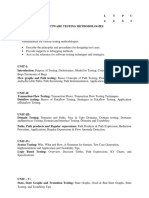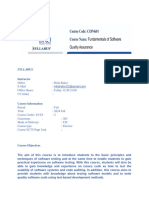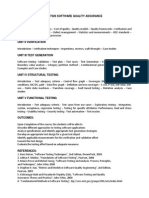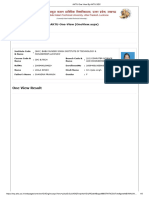software testing
Uploaded by
4L6 Rekhasoftware testing
Uploaded by
4L6 RekhaSOFT WARE TESTING
(ELECTIVE-IV)
M.Tech II Semester: Computer Science & Engineering
Course code Category Hours/week Credits Maximum Marks
20CO206 PE L T P C CIA SEE TOTAL
4 0 0 4 40 60 100
Contact Classes:60 Tutorial Classes: 0 Practical Classes: 0 Total Classes:60
OBJECTIVES:
The course should enable the students to:
1. Understand the concept of software testing objectives, process criteria, strategies and
methods.
2. Demonstrate various software testing issues and solutions in software like MODULE test,
integration, regression and system testing.
3. Demonstrate the techniques and skills on how to use modern software testing tools to
support software testing projects.
4. Understand important concepts of complexity metrics and object oriented metrics.
UNIT-I INTRODUCTION TO TESTING Classes:12
Introduction: Purpose of testing, dichotomies, model for testing, consequences of bugs, taxonomy
of bugs. Flow graphs and path testing: Basics concepts of path testing, predicates, path predicates
and achievable paths, path sensitizing, path instrumentation, application of path testing.
UNIT-II TRANSACTION FLOW TESTING Classes:12
Transaction flow testing: Transaction flows, transaction flow testing techniques, dataflow testing,
basics of dataflow testing, strategies in dataflow testing, application of dataflow testing.
UNIT-III LEVELS OF TESTING Classes:12
Domain testing: Domains and paths, nice and ugly domains, domain testing, domains and
interfaces testing, domain and interface testing, domains and testability. Logic based testing:
Overview, decision tables, path expressions, kv charts, and specifications.
UNIT-IV PATH PRODUCTS Classes:12
Paths, path products and regular expressions: Path products and path expression, reduction
procedure, applications, regular expressions and flow anomaly detection
UNIT-V TRANSITION TESTING Classes:12
State, state graphs and transition testing: State graphs, good and bad state graphs, state testing,
testability tips.
Text Books:
1. Boris Beizer, ―Software Testing Techniques‖, Dreamtech Press, 2nd Edition, 2003.
Reference Books:
1. P. C. Jorgenson, ―Software Testing: A Craftmen‘s Approach‖, Auerbach Publications, 3rd
Edition, 2013.
2. Perry, ―Effective Methods of Software Testing‖, John Wiley, 2nd Edition, 1999.
3. P. Nageswara Rao, ―Software Testing Concepts and Tools‖, Dream Tech Press, 2nd
Edition, 2007.
Web References:
1. http://www.qatutorial.com/?q=Software_Test_Metrics
2. http://softwaretestingfundamentals.com/MODULE-testing/
3. http://qainsights.com/challenges-in-test-automation/
4. http://www.softwaretestinghelp.com/manual-and-automation-testing-challenges/
E-Text Books:
1. http://www.softwaretestinghelp.com/practical-software-testing-new-free-ebook-
download/
2. http://www.guru99.com/software-testing.html
3. http://www.fromdev.com/2012/04/8-best-software-testing-books-every-qa.html
4. https://onlinecourses.nptel.ac.in/noc16_cs16/preview
Outcomes:
At the end of the course students able to
1. Apply software testing knowledge and engineering methods.
2. Design and conduct a software test process for a software testing project.
3. Identify the needs of software test automation, and define and develop a test tool to
support test automation.
4. Understand and identify various software testing problems, and solve these problems by
designing and selecting software test models, criteria, strategies, and methods.
5. Demonstrate the techniques and skills on how to use modern software testing tools to
support software testing projects.
6. Understand important concepts of complexity metrics and object oriented metrics.
TERM PAPER
M.Tech II Semester: Computer Science & Engineering
Course code Category Hours/week Credits Maximum Marks
20CO209 PC L T P C CIA SEE TOTAL
0 0 4 2 50 - 50
Contact Classes: 0 Tutorial Classes: 0 Practical Classes:20 Total Classes:20
The Term Paper is a self study report and shall be carried out either during II semester along with
other lab courses. Every student will take up this term paper individually and submit a report. The
scope of the term paper could be an exhaustive literature review choosing any engineering concept
with reference to standard research papers or an extension of the concept of earlier course work in
consultation with the term paper supervisor. The term paper reports submitted by the individual
students during the II semester shall be evaluated for a total of 50 marks for continuous assessment;
it shall be conducted by two Examiners, one of them being term paper supervisor as internal
examiner and an external examiner nominated by the Principal from the panel of experts
recommended by HOD.
You might also like
- Course Outline Software Testing and Quality AssuranceNo ratings yetCourse Outline Software Testing and Quality Assurance9 pages
- 4.7.4 - Software Testing & Quality AssuranceNo ratings yet4.7.4 - Software Testing & Quality Assurance3 pages
- IT_ 3223 Software Verification and Validation Course PlanNo ratings yetIT_ 3223 Software Verification and Validation Course Plan6 pages
- IT_ 3223 Software Verification and Validation Course PlanNo ratings yetIT_ 3223 Software Verification and Validation Course Plan6 pages
- University of Mumbai, Information Technology (Semester VII and Semester VIII) (Rev-2012)No ratings yetUniversity of Mumbai, Information Technology (Semester VII and Semester VIII) (Rev-2012)14 pages
- Format For Course Curriculum: Software Testing Course Level: UGNo ratings yetFormat For Course Curriculum: Software Testing Course Level: UG4 pages
- Jntu College of Engineering, Pulivendula Computer Science and Engineering DepartmentNo ratings yetJntu College of Engineering, Pulivendula Computer Science and Engineering Department16 pages
- CSE-323 Software Quality Engineering: Credit Hours 3 (2-3) Prerequisites None Teacher: Course DescriptionNo ratings yetCSE-323 Software Quality Engineering: Credit Hours 3 (2-3) Prerequisites None Teacher: Course Description4 pages
- CC 4158 New Course Handout - July-Nov 2022No ratings yetCC 4158 New Course Handout - July-Nov 20228 pages
- J B Institute of Engineering and Technology: Course Plan For Software Testing MethodologiesNo ratings yetJ B Institute of Engineering and Technology: Course Plan For Software Testing Methodologies40 pages
- Birla Institute of Technology & Science, Pilani: Work Integrated Learning ProgrammesNo ratings yetBirla Institute of Technology & Science, Pilani: Work Integrated Learning Programmes6 pages
- Essential Managed Healthcare Training for Technology Professionals (Volume 2 of 3) - Bridging The Gap Between Healthcare And Technology For Software Developers, Managers, BSA's, QA's & TA'sFrom EverandEssential Managed Healthcare Training for Technology Professionals (Volume 2 of 3) - Bridging The Gap Between Healthcare And Technology For Software Developers, Managers, BSA's, QA's & TA'sNo ratings yet
- SMSC Communication Protocol: Nuruddin AshrNo ratings yetSMSC Communication Protocol: Nuruddin Ashr44 pages
- Change The Calculation Logic To Use A Single Conversion Rate (Mb-8)No ratings yetChange The Calculation Logic To Use A Single Conversion Rate (Mb-8)6 pages
- Hik-opt-levant-1450453 Bomn Project (Cctv) - Bomn Hik-quote-00297344 (1)...No ratings yetHik-opt-levant-1450453 Bomn Project (Cctv) - Bomn Hik-quote-00297344 (1)...1 page
- DRS Functionality Impacted by Unhealthy State of The Vsphere Cluster Services (VCLS) (79892)No ratings yetDRS Functionality Impacted by Unhealthy State of The Vsphere Cluster Services (VCLS) (79892)5 pages
- An Introduction To Computing and Information SystemsNo ratings yetAn Introduction To Computing and Information Systems52 pages
- 11 Best Google Keeps Alternatives For 2024No ratings yet11 Best Google Keeps Alternatives For 202436 pages
- Administrative Task Script Name Description: Dont Forget GPMC ScriptsNo ratings yetAdministrative Task Script Name Description: Dont Forget GPMC Scripts4 pages
- Name - Praseet Paritosh Patro REG NO - 20BCE0630 Lab Assignment Da - 6No ratings yetName - Praseet Paritosh Patro REG NO - 20BCE0630 Lab Assignment Da - 65 pages
- Aktu One View by Aktu SDC - pdf2006480109029No ratings yetAktu One View by Aktu SDC - pdf20064801090295 pages
- User Guide Transfer-Unsettled-Accounts MA15190% (2)User Guide Transfer-Unsettled-Accounts MA15195 pages
- Building Real-Time Marvels with Laravel: Create Dynamic and Interactive Web Applications 1st Edition Sivaraj Selvaraj All Chapters Instant Download100% (2)Building Real-Time Marvels with Laravel: Create Dynamic and Interactive Web Applications 1st Edition Sivaraj Selvaraj All Chapters Instant Download41 pages
- Group 6 - IBB - Leveraging Blockchain in Land Registry - Real Estate SectorNo ratings yetGroup 6 - IBB - Leveraging Blockchain in Land Registry - Real Estate Sector9 pages
- Information Technology Outsourcing at BBCNo ratings yetInformation Technology Outsourcing at BBC4 pages
